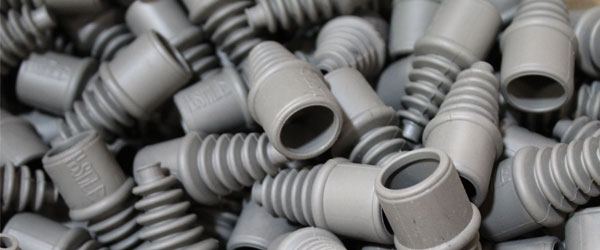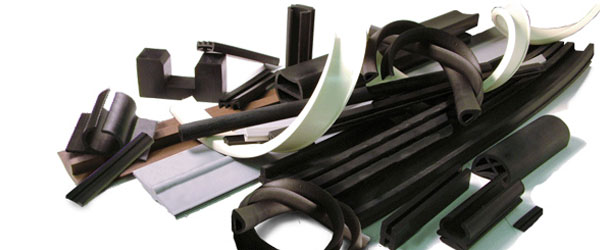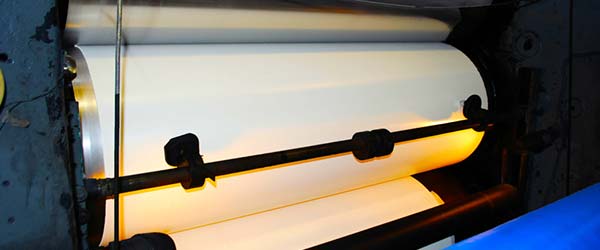RUBBER TECHNOLOGY: Ingredients, Activators, Fillers
Rubber Technology: Activators, Accelerators, Ingredients and Fillers
Return to Educational Switchboard
- Accelerator Activators
- Inorganic compounds – mainly metal oxides-zinc oxide, hydrated lime
- Organic Acids – Normally in combination with metal oxides
- Stearic, oleic
- Alkaline substances – will increase ph of rubber
- Usually increases cure rate
- Age Resistors (Antidegredants) – All rubbers are affected by aging
- Prevent or slow polymer breakdown caused by
- Ozone, oxygen, heat, light, weather
- Chemical Protectants – 3 types
- Amines – tend to discolor, “staining”
- Phenolics – nonstaining
- Phosphites – used as stabilizers for SBR
- Physical Protectants – waxy materials that bloom to surface forming a protective coat
- Shields the part from ozone, oxygen etc.
- Effects of oxygen on elastomers
- Softens (or usually softens) – NR, IR, IIr
- Hardens ( or usually hardens)- CR, SBR, NBR, BR, EPDM, CSM, FKM
- PHR – usually 2-3 phr
- Amines are about 65% of the age resistors
- Softeners (Physical plasticizers)
- Used as processing aid (2-10 phr) or to alter the finished part (up to 100 phr)
- Do not react chemically with the compound, modify physical characteristics
- Must be compatible with rubber and other compounding ingredients. Incompatibility will result in “bleeding” in the final product or poor processing characteristics or both.
- Typical for plasticizers to act a dual purpose ingredients, increase elongation, reduce hardness, improve tack; depending on the amount and type used and the rubber involved
- Miscellaneous ingredients – used when a particular effect or property are required in a vulcanizite. For example:
- Abrasives – Erasers, Grinding and Polishing wheels
- Mineral ingredients such as ground silica and pumice
- Blowing Agents – gas-generating chemical needed for sponge and microporous rubber
- Release gas during vulcanization
- Azo compounds and carbonates
- Colorants – inorganic pigments or organic dyes
- Must be stable, color-fast and inexpensive
- Flame Retardants
- Chlorinated hydrocarbons, phosphate and antimony
- Homogenizing Agents – aid in blending two or more elastomers
- Reduce processing time and unify blends
- Odorants – screen out or mask odors in compounds
- Retarders – reduce accelerator activity during processing and storage
- Should decompose or not interfere with accelerator during normal vulcanization
- Generally, these are organic acids that function by lowering ph of compound, thus retarding vulcanization
- Abrasives – Erasers, Grinding and Polishing wheels
Fillers – used to extend, color, reinforce and cheapen compounds
- Blacks
- Clays – semi reinforcing
- Many types but Kaolins are used exclusively in rubber
- Fine Particle (<2 microns) – Hard Clays – Hard Duro imparted
- Soft clays lead to soft durometer
- Calcining (removing bound water) can impart good di-electric strength
- Increases cost and decreases reinforcement
- Silane Coupled Clays have increased modulus and tensile
- Duro is starting point for deciding how much phr
- rule of thumb is 5-6 phr hard clay or 7-8 phr soft clay
- Main factor to consider with clays is the reduction in cure rate. Accelerators or Activators needed
- Hard clay at equal loadings to N-990 produces similar properties in Tensile, Tear and Abrasion but is deficient in Modulus and compression set.
- Calcium carbonate – extending fillers
- Precipitated silica (reinforcing)
- used alone reinforces significantly less due to its high polarity and that rubber and silica have differing polarities
- Therefore, organosilanes are used (organic silica compounds) to act as coupling agents between rubber and silica.
- Chemical Reinforcement: Covalent bonds between fillers and rubbers – Mineral Fillers
- Silica-Silane – the Magic Triangle
- Roling Resistance, Wear Resistance , Wet Grip
- Reduces Rolling Resistance by 25% and fuel consumption by 5% over carbon black
- However, Processing is more difficult because the chemical reaction must take place. Now time, temperature are crucial.
- Bonding Fillers to Rubber – Bifunctional Organosilanes use two groups:
- Trialkoxy Silyl Group – builds stable siloxane bonds (filler modifier)
- Rubber Active Group – reacts with polymer during vulcanization and develops covalent filler-rubber bonds. These bonds are responsible for the high reinforcing potential of the silica-silane filler system.
- Both chemical reactions have to be carefully controlled.
- ensure coupling agents are thoroughly mixed
- Also ensure a reaction with the polymer matrix doesn’t occur in mixing
- The highest reinforcement of non-black fillers
- Noted for unique combination of tear strength, abrasion resistance, adhesion, age resistance, color and economics.
- Manufactured by the controlled precipitation from sodium silicate with acid or alkaline earth metal salt.
- Particle size is controlled by the conditions of precipitation.
- Variety of highly to medium reinforcing grades
- Vary in ph from slightly acidic to slightly alkaline
- Since they are hydrated, they absorb ambient moisture.
- Fumed Silicas – aka “pyrogenic’ or ‘anhydrous’
- smallest particle-size silicas
- High Priced
- Only really used in high quality silicone rubber products
- The only fillers combining high reinforcement, high-temperature stability, electrical properties, and the transparency for which silicones are known.
Compounding with Silicas
- Adding silicas tends to increase viscosity quicker than other fillers.
- This is especially with high surface area (small particle size- hard) silicas
- The most frequently used accelerator systems are deactivated by silicas
- both optimum cure and rate of cure are reduced
- Early addition of zinc oxide and silica results in lower Mooney Viscosity, greater die swell and lower modulus.
- Withholding zinc oxide until the silica is dispersed raises viscosity.
- Certain activators used with silica-filled rubber reduces viscosity greatly
- Diethylene glycol (DEG) and Triethanolamine (TEA) at 2 phr can reduce viscosity by 30%
- Polyethylene glycol (PEG) is only half as effective
- Viscosity can also be reduced by using hydrocarbon process oils
- In Natural Rubber with Silicas, Plasticizers of vegetable origin have special characteristics, 5 phr of Tall Oil is equivalent to 30 phr of napthenic oil.
- In SBR, aromatic resins have advantages with silica fillers.
- Coumarone-indene resins aid in incorporation rate and dispersion
- Tensile, tear, abrasion and extrusion smoothness are superior with 10-20 phr aromatic resin as process oil
- Curing Systems
- The surface chemistry of precipitated silicas differ significantly from other fillers. This leads to a unique set of compounding variations. Sulfur-cured rubbers containing precipitated silica must be modified to obtain optimum performance.
- With fine particle silicas above about 20phr, diethylene glycol (DEG) or polyethylene glycol (DEG) reduces accelerator requirements. The glycols also buffer the variable moisture and are an economic advantage.
- Efficient Vulcanization systems (EV) rely on sulfur donors or accelerators with available sulfur and little or no elemental sulfur.
- General guidelines:
- Combine two or more accelerators, one from the thiazoles or sulfonamides, the second from the guanidines, thiurams, or dithiocarbamates
- Add glycol activators (TEA, DEG, PEG) to lessen accelerator demand and buffer variable moisture
- Sulfur Donor (EV) systems that provide efficient crosslinking, property optimization and heat-aging
- Vulcanazite Properties – assume good state of cure
- low modulus compared to carbon black in similar particle size
- Tensile strength is similar in above
- Higher elongation at break and lower resistance to abrasion
- Resistance to Abrasion increases with surface area
- High Tear is outstanding with silica and it increases with increasing surface area
- Rubber filled with small-particle silicas tears in an irregular “saw-tooth” process often called ‘knotty tear’.
- Important that optimum state of cure is reached
- Reinforcement is enhanced with coupling agents
- mercaptopropyltrimethoxysilane sis the most effective
- produces strong adhesion between silica and rubber, resulting to substantial increase in reinforcement
- With silanes, it is important to allow the silica, rubber and silane to mix thoroughly before adding other ingredients
- It is particularly important that zinc oxide not be present during this phase
- Rather, add zinc oxide late in 1st stage or in 2nd stage to avoid interference with coupling action
- Only ingredients essential for processibility (plasticizers) be present during early mixing cycle
- It is particularly important that zinc oxide not be present during this phase
- mercaptopropyltrimethoxysilane sis the most effective
- Silicone-Rubber Compounding
- Three types of silica used:
- Fumed – highest strength and best electrical properties
- Precipitated – moderately good tensile strength, tear strength, and water absorption and electrical properties at an intermediate cost.
- Special grades offer better electrical properties and reduced water absorption
- Water Volume swell after 24 hrs is 1-2% with fumed and 5-10% with precipitated
- Three types of silica used:
- Titanium dioxide – pigmenting filler
 (909) 987-1774
(909) 987-1774 Email Us
Email Us






